October 26, 2025
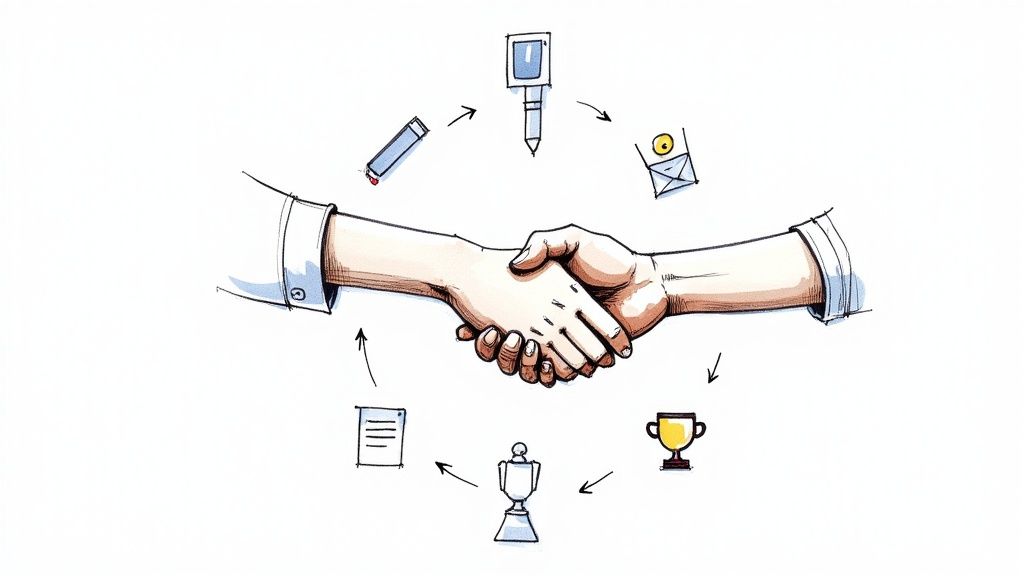
Asking for sponsorship is a lot like dating. You wouldn't ask someone to marry you on the first date, right? The same logic applies here. A successful "ask" is the result of laying a strong groundwork long before you ever send that first email.
You're not just asking for money; you're building a foundation for a real partnership. It all starts with knowing your own value and finding brands that will genuinely benefit from what you offer.
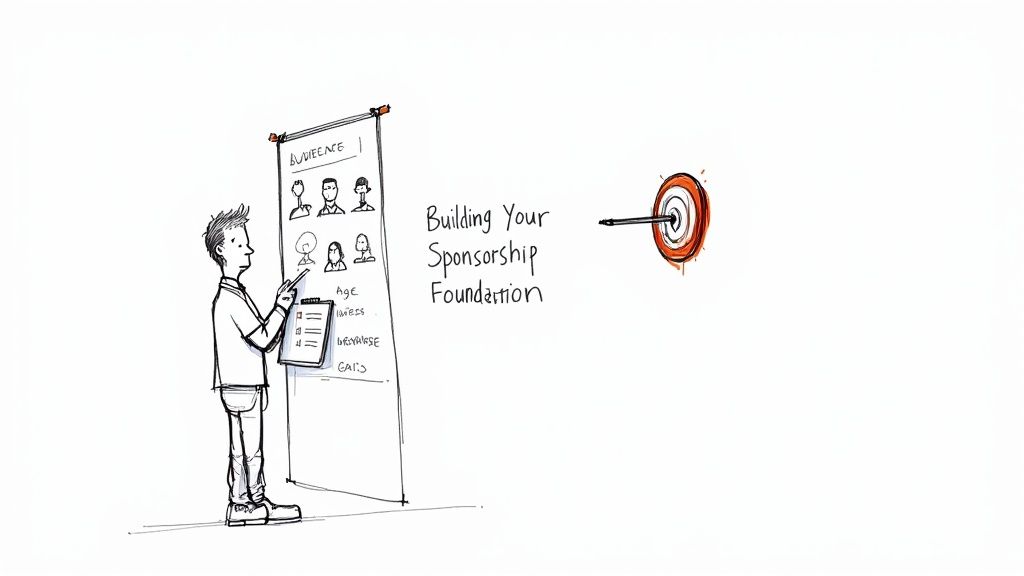
Before you can confidently ask a brand to invest in you, you need absolute clarity on what you bring to the table. This is the single most overlooked step, and it's what separates a compelling proposal from one that gets instantly deleted.
Forget what a sponsor can do for you. For now, focus entirely on what you can do for them.
This means taking a hard look at your own project, event, or community. Who are you actually reaching? What do they care about? Sponsors aren't just buying logo placements; they're buying access to a specific, engaged audience that matches their ideal customer profile. The more data you have, the more compelling your story becomes.
Pro Tip: Change your mindset from "asking for a donation" to "offering a marketing opportunity." A sponsor is a business partner, and they need to see a potential return on their investment, whether that's brand exposure, new leads, or positive community association.
So, what makes partnering with you a no-brainer? Don't settle for generic benefits like "brand awareness." Dig deeper. Is it your hyper-niche audience of urban gardeners? Your innovative virtual summit format? Your off-the-charts community engagement on Discord?
Get specific. Here’s what to nail down:
Once you know your value, you can start building a targeted list of potential sponsors. Spraying and praying by emailing every company in town is a guaranteed recipe for failure. Quality over quantity is the name of the game.
Your mission is to find businesses whose marketing goals and target audience overlap with yours. Our guide on https://groupos.com/blog/how-to-find-corporate-sponsorship offers a really structured way to tackle this research.
The sponsorship world is huge and competitive. Think about this: the global value of sports media rights alone is projected to hit over $60 billion in 2025. While that shows there's money out there, it also screams competition.
Here’s a powerful example of why alignment matters: in the U.S., soccer has exploded in popularity. A recent study found that 67% of its fans say they find brands that sponsor their favorite competitions more appealing. That's the magic you're trying to create—finding an audience that will love a sponsor for supporting something they care about.
Before you jump into outreach, it's a good idea to make sure you have all your ducks in a row.
Use this quick reference to confirm you have all the essential elements ready before starting your outreach.
This foundational work isn't glamorous, but it's the most critical part of the entire process. A well-researched, highly targeted approach, which involves mastering outbound lead generation strategies, proves you're a serious professional who respects a sponsor's time and budget. It dramatically increases your odds of getting that "yes."
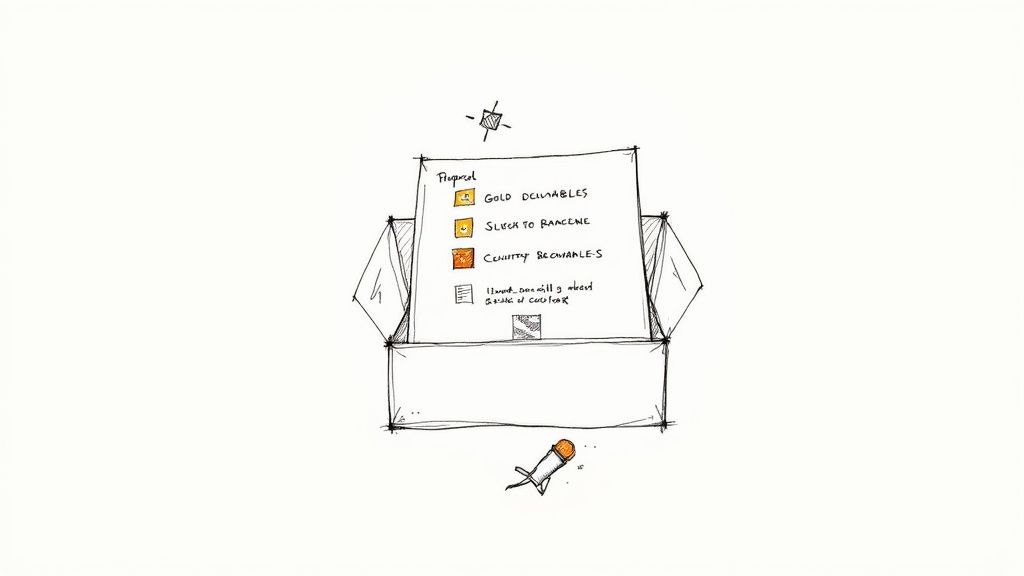
Let's be blunt: a generic, one-size-fits-all proposal is a waste of everyone's time. It's the fastest way to land in the trash folder. Your sponsorship proposal needs to be your champion—a custom-tailored sales tool that speaks directly to a potential sponsor’s world.
Think of it as the ultimate first impression. It has to be professional, look great, and most importantly, show that you've done your homework on them. You’re not just asking for money; you're offering them a golden opportunity to connect with an audience they desperately want to reach.
Your proposal has one job: to immediately answer their silent, all-important question: "What's in it for us?"
A marketing manager is busy. They don't have time to solve a puzzle. Your proposal needs to be a clear, straightforward story that takes them from "Who are you?" to "This makes perfect sense."
Here’s a simple structure that I’ve seen work time and time again:
This isn't just a checklist; it's a narrative that guides them toward seeing the undeniable return on their investment.
Forget asking for a single dollar amount. The real game-changer is offering tiered packages—think Gold, Silver, and Bronze. This simple shift empowers sponsors to find a fit for their specific budget and goals, which dramatically increases your chances of getting a "yes."
But here's where most people go wrong. The key is to make the benefits at each level feel distinct and genuinely valuable.
Pro Tip: Don’t just stack on more logo placements as the price goes up. Instead, offer different kinds of value. A lower tier can focus on brand visibility, while a premium tier should offer something more tangible, like direct lead generation or an exclusive speaking slot.
When you detail your packages, vague promises are your enemy. Get granular.
This level of detail proves you're a serious partner who has thought through the value exchange. It also gives your contact the ammunition they need to justify the expense to their boss. For a closer look at how these tiers come together, checking out a well-built sample sponsorship proposal can give you a fantastic template to work from.
Words will only get you so far. A truly killer proposal uses hard data to make a logical case and compelling visuals to make an emotional one. Don't just tell them you have an engaged community—show them.
Weave in stats and graphics that pop off the page:
This data-driven approach is no longer a "nice-to-have." Sponsors are under more pressure than ever to prove ROI on every dollar they spend. By providing this information upfront, you position yourself as a strategic partner who understands their business needs. You're not just asking for a handout; you're presenting a solid business case with a clear path to success.
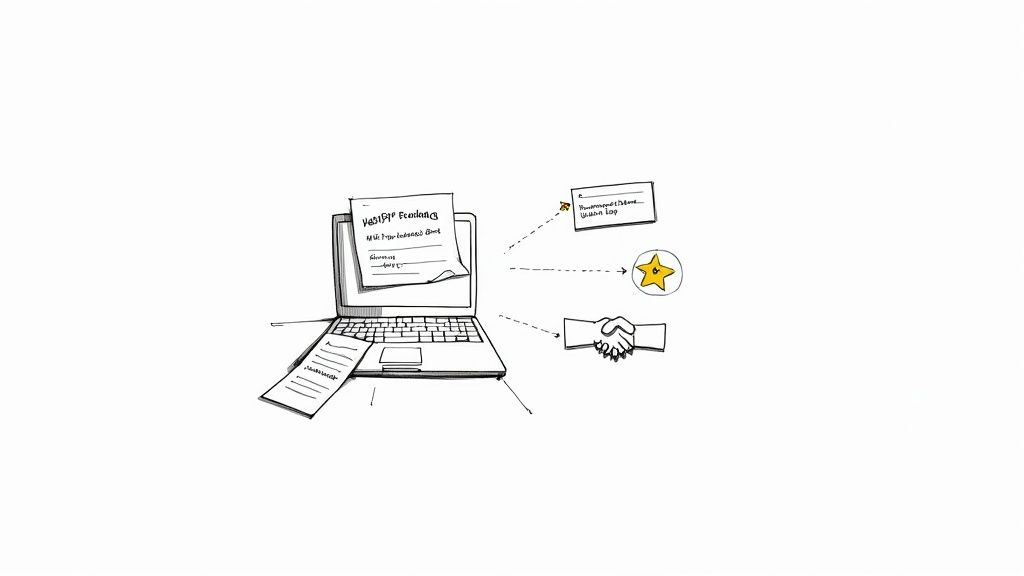
Alright, you've done the hard work of building a killer sponsorship proposal. Now comes the moment of truth: reaching out. This is where so many people stumble, blasting out generic, copy-paste emails that get deleted on sight.
Let's be clear about the goal here. Your first email isn't meant to close the deal. Not even close. Its sole purpose is to get a conversation started. You're trying to pique their interest and show you're a professional who has done their homework. This is about relationship building, not just a one-off transaction.
Before you even think about writing an email, you have to figure out who to send it to. Firing off your proposal to a generic "info@" email address is a fast track to the spam folder. Same goes for emailing the CEO of a huge corporation. It just won’t get seen.
You need to find the actual human being whose job it is to look at opportunities like yours. Their title will vary, but you're generally looking for someone like a:
So, how do you find them? LinkedIn is your best friend. Get on there and start searching for people with those titles at the companies on your list. Once you have a name, you can use tools like Hunter.io or RocketReach to make an educated guess at their email address. This little bit of detective work is absolutely essential and will make a world of difference.
Your first email needs to be short, sharp, and all about them. Don't make the classic mistake of attaching your full proposal right away—it's overwhelming and feels presumptuous. Think of this first message as a "pre-proposal."
Show them you've done your research. Mention a specific project they've worked on or a company value that resonates with what you're doing. This immediately separates you from the 90% of people sending generic pitches.
Here’s a simple template I've had success with:
"Hi [Name],
I've been following [Company Name]'s recent work on [mention a specific initiative], and I was really impressed by the focus on [mention a shared value, e.g., 'community engagement'].
My organization, [Your Org Name], is about to launch [Your Project/Event], which connects with [number] of [your audience demographic]—an audience I know is important to you. I have a couple of specific ideas for how a partnership could directly support your goals.
Would you be open to a quick 15-minute chat next week to see if there's a good fit?"
See how that works? It's respectful, it shows you've put in the effort, and it gives them a clear, low-commitment next step.
More often than not, you won't get a reply to your first email. Don't panic. This is completely normal. People are buried in emails, and a polite follow-up is a standard part of the game. The trick is to add value, not just be annoying.
Here’s a simple follow-up rhythm that works without being pushy:
Getting this outreach phase right is what separates the pros from the amateurs. It positions you as a thoughtful, strategic partner, which makes every subsequent step—from negotiation to execution—that much easier.
So, you've made it this far. Your outreach was on point, the proposal resonated, and now you have a potential sponsor who is genuinely interested. That’s a massive win, but don’t start celebrating just yet. The real work is about to begin.
This is the negotiation phase, where a promising chat turns into a signed, sealed, and delivered partnership. This isn't about arm-wrestling or trying to "win." The best sponsorships are born from a collaborative spirit where both sides walk away feeling like they got incredible value. Your goal here is to confidently talk terms and build a deal that sets everyone up for success.
How you approach this stage can be the difference between a one-off transaction and a powerful, long-term alliance.
Walking into a negotiation blind is the fastest way to leave money and opportunity on the table. Before you ever get on a call, you need to know your position inside and out. This goes way beyond just knowing what you want; it’s about understanding your walk-away point.
First, define your bottom line. What’s the absolute minimum you need—financially or through in-kind support—to make this partnership a smart move? Knowing this number cold prevents you from getting talked into a deal that actually ends up costing you.
Next, identify where you have some wiggle room. Are there benefits in your proposal that are easy for you to add? Maybe it’s an extra social media shout-out or a slightly better logo placement. These are your bargaining chips, so know which ones you’re willing to play.
A key concept here is your BATNA—your Best Alternative to a Negotiated Agreement. If this deal doesn't work out, what's your Plan B? Having a solid backup gives you the power to say no to a bad offer.
Sponsors are smart. They will almost always have questions or push back on a few items. Don't take it personally or see it as a bad sign. It’s actually a good thing. It means they're engaged and taking this seriously. How you handle these moments can build a huge amount of trust.
Here are a few scenarios you're likely to run into:
Remember, cash isn't the only king. In-kind sponsorships, where a company gives you goods or services instead of a check, can be pure gold. Think of a tech company providing event software, a local brewery supplying the drinks, or a marketing firm running your ad campaign.
The negotiation process is largely the same, but you have to be crystal clear about the value of what's on the table.
For instance, if a local printer offers to produce all your event signage and you determine that's worth $3,000, you can confidently welcome them as a "Silver" sponsor and give them all the perks that come with that level of investment.
Once you’ve shaken hands (even virtually), it's time to get it on paper. A verbal agreement is just asking for trouble down the line. A formal, written contract protects both you and your sponsor by making sure everyone is 100% on the same page.
You'll typically use one of two documents to seal the deal:
It might feel like a bit of a bureaucratic hoop to jump through, but a solid contract is your best friend. It removes any gray areas and creates a clear roadmap for a successful partnership.
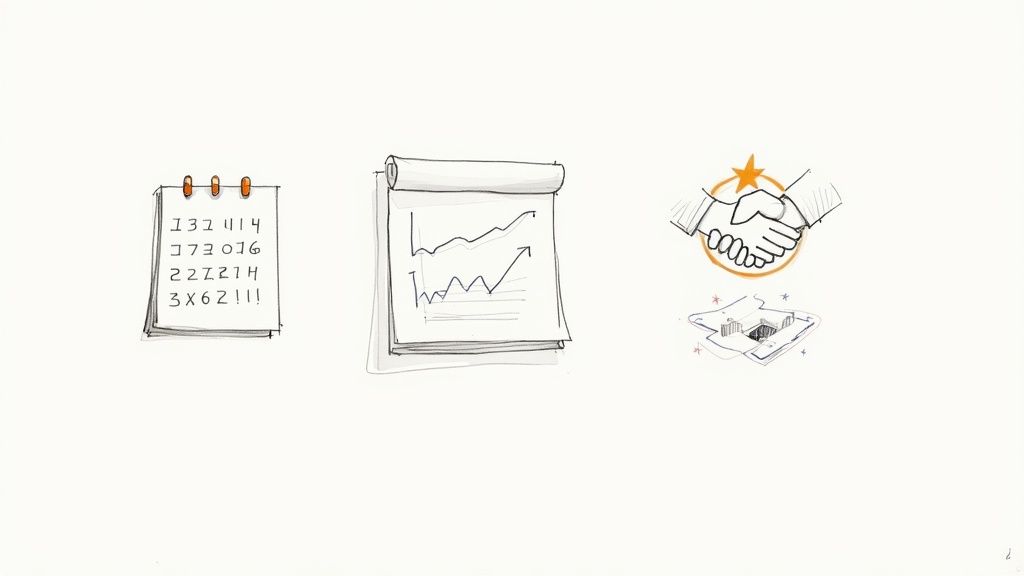
The contract is signed and the check has cleared. It’s a huge win, but this is the starting line, not the finish line. How you handle the relationship after getting the "yes" is what separates a one-off sponsor from a long-term partner who renews year after year.
This next phase is all about flawless execution and making your sponsor feel like a true partner. You made a series of promises in your proposal, and now it's time to deliver on every single one. Better yet, it's time to go above and beyond to prove they made a smart investment.
The goal is no longer just securing the sponsorship; it's about making the partnership so successful that renewing becomes the easiest decision your sponsor makes all year.
You can't just hope for the best. To make sure nothing falls through the cracks, you need a detailed sponsorship activation plan. Think of this as your internal roadmap that turns the contractual agreement into a checklist of concrete tasks and deadlines.
This is your project plan for the partnership. It should clearly outline every single deliverable, assign it to someone on your team, and give it a hard due date.
It’s also a smart move to assign a single point of contact for your sponsor. This person becomes their go-to guide, ensuring questions get answered quickly and they always feel taken care of. This one step can prevent a world of miscommunication and makes the whole experience feel seamless.
Don’t ever make your sponsor ask for an update. Get ahead of it. Proactive communication is a massive trust-builder and shows you’re on top of your game. A simple bi-weekly email with a few bullet points on progress can work wonders.
This regular check-in demonstrates professionalism and keeps them engaged in the journey. Share small wins as they happen! A screenshot of a high-performing social post or a quick note about positive feedback mentioning their brand makes them feel part of the success.
These small updates become the building blocks for your most important document: the post-event impact report. This isn't just a thank-you note; it’s your proof of performance and your secret weapon for securing a renewal.
The sponsorship world has changed. Gone are the days when brands were happy with just seeing their logo on a banner. Today, everything is about measurement and ROI. In fact, a whopping 81% of brands now prioritize measurement in their sponsorship strategies, a huge jump from just 57% five years ago. Sponsors demand hard proof that their investment paid off.
This is where your post-event report becomes your most powerful asset. It’s a data-driven story that proves you delivered on your promises and generated a tangible return for their brand. Make it visually appealing and easy to digest, combining hard numbers with compelling highlights.
For a comprehensive breakdown of what to track, our guide on measuring event ROI provides an excellent framework for capturing the right data.
Your report must include specific metrics that tie directly back to the goals you discussed during your initial negotiations.
This simple tracking template can help you gather the data you need for your final report. As you complete each deliverable, log the results.
By presenting a professional, data-backed case that clearly shows their investment was a success, you’re not just ending a campaign—you’re starting the conversation for next year. End your report with a forward-looking statement that opens the door for an even bigger and better partnership.
When you're first figuring out how to get sponsors, a few key questions always seem to pop up. Let's be honest, getting this stuff wrong can kill a deal before it even starts. So, let's clear the air on the most common hurdles I see people face.
There’s no magic number here. The amount you ask for has to be rooted in the real-world value you’re offering, not just what you need to cover your costs. The first step is simple math: add up every single expense for your event or project. That's your baseline.
But here's where the real work begins. You have to flip the script and think like the sponsor. What are they actually buying? Dig into the market value of what you're offering. This means knowing your audience demographics, your social media engagement rates, and how well your brand fits with theirs. This is the data that will back up your price tag.
A great way to approach this is by building out tiered packages—think Gold, Silver, and Bronze. This gives potential sponsors options and lets them pick a level that fits their budget and marketing goals. Do a little homework and see what similar events in your space are charging. You want your pricing to be competitive, not a wild guess.
The most important thing to remember is this: You’re pricing the value you deliver to the sponsor, not just asking them to cover your bills. They're investing in a marketing opportunity, and your price needs to reflect that.
Easy. Sending a generic, one-size-fits-all proposal. It's the fastest way to get your email deleted. Sponsors can spot a copy-and-paste job from a mile away, and it instantly signals that you haven't done your homework.
It's tempting to just blast your proposal out to a massive list of companies and hope something sticks. Don't do it. That's a rookie move.
Instead, put in the time upfront. For every single company you approach, you need to understand what they're doing. Look at their recent marketing campaigns, who they're trying to reach, and what their company values are. Then, tailor your proposal to show exactly how partnering with you helps them hit their goals. A personalized pitch shows you’re serious about a real partnership, not just looking for a quick check.
Shooting your proposal to a generic info@company.com email address is like throwing it into a black hole. You have to get past the gatekeepers and land in the inbox of someone who can actually say "yes."
Hint: It's almost never the CEO. You're looking for people whose job it is to think about marketing, brand partnerships, or community engagement. LinkedIn is your best friend here. Search for titles like:
Once you've got a name, a little more digging can usually turn up their email address. If you’re stuck, find someone else in the marketing department and send a polite, brief email asking who the best person is for sponsorship opportunities. A little resourcefulness goes a long way.
Once the deals start rolling in, juggling all the moving parts—from tracking deliverables to proving ROI—gets complicated fast. An all-in-one platform like GroupOS can be a lifesaver. It helps you manage everything from creating dedicated sponsor profile pages to tracking engagement on banner ads. It lets you focus on building great relationships instead of getting buried in spreadsheets. Check out the tools over at https://groupos.com.


